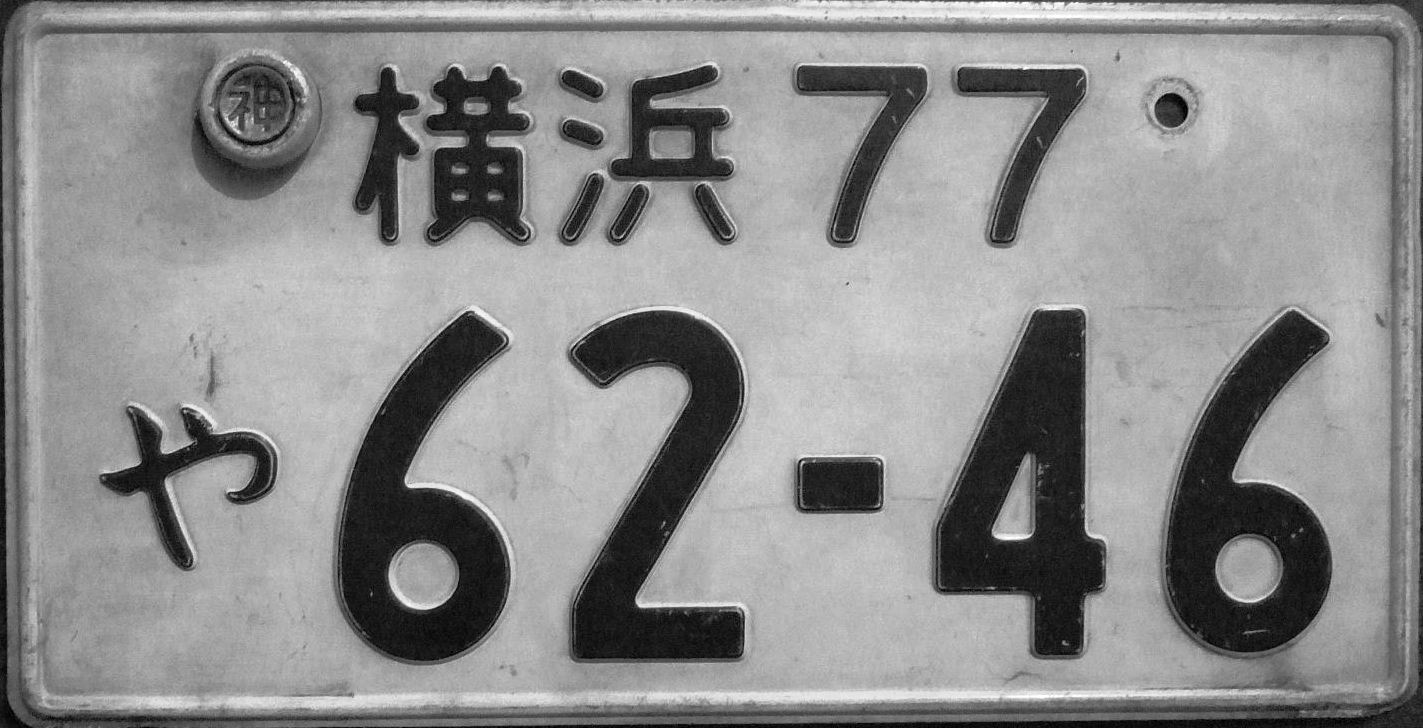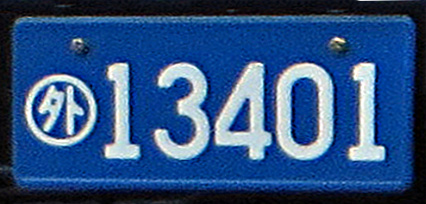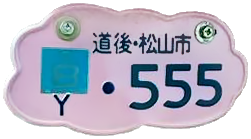Japanese License Plates on:
[Wikipedia]
[Google]
[Amazon]
In 

 Official vehicles of the Imperial household are exempt from the requirement to display such plates. Official vehicles of the Self-Defense Forces and the foreign diplomats are required to display other plates.
Official vehicles of the Imperial household are exempt from the requirement to display such plates. Official vehicles of the Self-Defense Forces and the foreign diplomats are required to display other plates.
 The plates are installed on both the front and rear of the vehicle, with the rear plate permanently attached to the vehicle with a prefecture seal completely covering one of the attaching plate bolts. The plate is only removed when the vehicle is sold secondhand to someone from a different prefecture, has reached the end of service and has been sold for scrap, or exported. New vehicles are not delivered to the purchaser until the plates have been attached at the dealership.
Since November 1, 1970, a "jikō-shiki" (字光式) plate has been offered for private vehicles at the owner's request. The green characters on this type of plate are replaced with molded green plastic that can be illuminated from behind the plate. From May 19, 1998, specific numbers can also be requested if the numbers are not already in use. From 2010, these are also available in blue version of vehicle registration plates started in 1973.
The international vehicle registration code for Japan is J.
The plates are installed on both the front and rear of the vehicle, with the rear plate permanently attached to the vehicle with a prefecture seal completely covering one of the attaching plate bolts. The plate is only removed when the vehicle is sold secondhand to someone from a different prefecture, has reached the end of service and has been sold for scrap, or exported. New vehicles are not delivered to the purchaser until the plates have been attached at the dealership.
Since November 1, 1970, a "jikō-shiki" (字光式) plate has been offered for private vehicles at the owner's request. The green characters on this type of plate are replaced with molded green plastic that can be illuminated from behind the plate. From May 19, 1998, specific numbers can also be requested if the numbers are not already in use. From 2010, these are also available in blue version of vehicle registration plates started in 1973.
The international vehicle registration code for Japan is J.
* These plates are issued by municipal governments.
; Large
: 44x22 cm (17.3x8.7 inch)
: (for over 8 tons vehicle, or capacity of 30 people or more)
; Medium
: 33x16.5 cm (13x6.5 inch)
; Small
: 23x12.5 cm (9x4.9 inch)
; Extra small
: about 20x10 cm (7.8x3.9 inch)
: (differs according to each municipality)
Until 31 December 1974, kei cars had small green and white license plates. After this date, they received medium plates, now in black and yellow to distinguish them from regular cars.
''Please note that, to avoid any claims of invasion of privacy, the artist of these pictures has deliberately selected an invalid combination of characters.''
The illustration shows what a plate might look like. The top line contains the name of the issuing office ( Tama, shown, is in Tokyo) and a vehicle class code. The bottom line contains a

 Vehicles owned by personnel with the United States military in Japan under the
Vehicles owned by personnel with the United States military in Japan under the
 Because the
Because the
Japanese Government Ministry of Land, Infrastructure and Transport (English page)
{{Asia in topic, Vehicle registration plates of
Japan
Japan ( ja, 日本, or , and formally , ''Nihonkoku'') is an island country in East Asia. It is situated in the northwest Pacific Ocean, and is bordered on the west by the Sea of Japan, while extending from the Sea of Okhotsk in the north ...
, the national government issues vehicle registration plate
A vehicle registration plate, also known as a number plate (British English), license plate (American English), or licence plate ( Canadian English), is a metal or plastic plate attached to a motor vehicle or trailer for official identificati ...
s for motor vehicles
A motor vehicle, also known as motorized vehicle or automotive vehicle, is a self-propelled land vehicle, commonly wheeled, that does not operate on Track (rail transport), rails (such as trains or trams) and is used for the transportation of pe ...
through the Ministry of Land, Infrastructure, Transport and Tourism
The , abbreviated MLIT, is a ministry of the Japanese government.国土交通省設置法 ...
Land Transportation Offices nationwide. However, the local municipality
A municipality is usually a single administrative division having corporate status and powers of self-government or jurisdiction as granted by national and regional laws to which it is subordinate.
The term ''municipality'' may also mean the go ...
rather than the national government registers certain vehicles with small engine displacements.
The number on the top line is a vehicle class code which begins with a 0 through 9 to indicate specific vehicle classification. This is signified by the length, width and height of the vehicle as well as engine displacement. Broadly speaking, passenger automobiles with engine displacements at or smaller than 2000 cc receive 5-series plates, while passenger automobiles with engine displacements larger than or more receive 3-series license plates.


 Official vehicles of the Imperial household are exempt from the requirement to display such plates. Official vehicles of the Self-Defense Forces and the foreign diplomats are required to display other plates.
Official vehicles of the Imperial household are exempt from the requirement to display such plates. Official vehicles of the Self-Defense Forces and the foreign diplomats are required to display other plates.
 The plates are installed on both the front and rear of the vehicle, with the rear plate permanently attached to the vehicle with a prefecture seal completely covering one of the attaching plate bolts. The plate is only removed when the vehicle is sold secondhand to someone from a different prefecture, has reached the end of service and has been sold for scrap, or exported. New vehicles are not delivered to the purchaser until the plates have been attached at the dealership.
Since November 1, 1970, a "jikō-shiki" (字光式) plate has been offered for private vehicles at the owner's request. The green characters on this type of plate are replaced with molded green plastic that can be illuminated from behind the plate. From May 19, 1998, specific numbers can also be requested if the numbers are not already in use. From 2010, these are also available in blue version of vehicle registration plates started in 1973.
The international vehicle registration code for Japan is J.
The plates are installed on both the front and rear of the vehicle, with the rear plate permanently attached to the vehicle with a prefecture seal completely covering one of the attaching plate bolts. The plate is only removed when the vehicle is sold secondhand to someone from a different prefecture, has reached the end of service and has been sold for scrap, or exported. New vehicles are not delivered to the purchaser until the plates have been attached at the dealership.
Since November 1, 1970, a "jikō-shiki" (字光式) plate has been offered for private vehicles at the owner's request. The green characters on this type of plate are replaced with molded green plastic that can be illuminated from behind the plate. From May 19, 1998, specific numbers can also be requested if the numbers are not already in use. From 2010, these are also available in blue version of vehicle registration plates started in 1973.
The international vehicle registration code for Japan is J.
Appearance
hiragana
is a Japanese syllabary, part of the Japanese writing system, along with ''katakana'' as well as ''kanji''.
It is a phonetic lettering system. The word ''hiragana'' literally means "flowing" or "simple" kana ("simple" originally as contrast ...
character and a four-digit serial number divided into two groups of two digits separated by a hyphen. Any leading zeroes are replaced by centered dots.
White plates can have the following hiragana (bold indicates rental vehicle characters):
さすせそたちつてとなにぬねのはひふほまみむめもやゆよらりるろれわ''
Green plates can have the following hiragana:
あいうえかきくけこを
Some characters, including ones with a dakuten
The , colloquially , is a diacritic most often used in the Japanese kana syllabaries to indicate that the consonant of a syllable should be pronounced voiced, for instance, on sounds that have undergone rendaku (sequential voicing).
The , co ...
or a handakuten, be used on any plates, including the yellow and black ones:
'ばだがぱざびぢぎぴじぶづぐぷずべでげペぜぼどごぽぞゑゐ''
A license plate
A vehicle registration plate, also known as a number plate (British English), license plate (American English), or licence plate ( Canadian English), is a metal or plastic plate attached to a motor vehicle or trailer for official identificati ...
in Japan
Japan ( ja, 日本, or , and formally , ''Nihonkoku'') is an island country in East Asia. It is situated in the northwest Pacific Ocean, and is bordered on the west by the Sea of Japan, while extending from the Sea of Okhotsk in the north ...
thus follows this format: KK?*H##-## (e.g., 足立500き21-41), where KK is the name of the issuing office in kanji
are the logographic Chinese characters taken from the Chinese family of scripts, Chinese script and used in the writing of Japanese language, Japanese. They were made a major part of the Japanese writing system during the time of Old Japanese ...
, H is a hiragana, ? is a 5 for vehicles less than 2000 cc and a 3 for vehicles greater than 2000 cc (other numbers are less common—1 for large trucks, 2 for buses, etc.), * is a number from 0 to 99 (pre-1971 license plates will omit this), and # is a number from 0* to 9 (*leading zeroes are replaced by centered dots).
Special use plates

 Vehicles owned by personnel with the United States military in Japan under the
Vehicles owned by personnel with the United States military in Japan under the Status of Forces Agreement A status of forces agreement (SOFA) is an agreement between a host country and a foreign nation stationing military forces in that country. SOFAs are often included, along with other types of military agreements, as part of a comprehensive security ...
(SOFA) have a "Y" on white plates, or an "A" on yellow plates, where the hiragana character is normally displayed. Earlier versions of the SOFA license plate displayed the letters "K", "M", "G", "H" and "E". These letters indicated the car was imported into Japan under SOFA and was left-hand drive. Today, cars with an "E" indicate that Japanese sales tax has not been paid and the vehicle will not remain in Japan when the military member departs. Since the 1980s, military commands have discouraged servicemembers assigned to Japan from shipping their vehicles from the U.S. into the country, so this is rarely seen. Military members who retire in Japan use the hiragana "よ". Many opt to purchase second-hand domestic vehicles through used car dealers off-base, and from other servicemembers departing Japan at on-base "lemon lots".
Out of country plates
 Because the
Because the Japanese writing system
The modern Japanese writing system uses a combination of logographic kanji, which are adopted Chinese characters, and syllabic kana. Kana itself consists of a pair of syllabaries: hiragana, used primarily for native or naturalised Japanese wo ...
, particularly the ''kana
The term may refer to a number of syllabaries used to write Japanese phonological units, morae. Such syllabaries include (1) the original kana, or , which were Chinese characters (kanji) used phonetically to transcribe Japanese, the most pr ...
'', is unique to Japan, standard-issue Japanese license plates are considered unacceptable for international travel. If motorists wish to take their vehicles abroad with them, the Ministry of Transport will issue them with plates with the hiragana and kanji scripts replaced by Roman letters. The hiragana prefix is replaced by a Kunrei-shiki
is the Cabinet-ordered romanization system for transcribing the Japanese language into the Latin alphabet. Its name is rendered ''Kunreisiki rômazi'' in the system itself. Kunrei-shiki is sometimes known as the Monbushō system in English bec ...
romanization
Romanization or romanisation, in linguistics, is the conversion of text from a different writing system to the Roman (Latin) script, or a system for doing so. Methods of romanization include transliteration, for representing written text, and ...
of that character. The kanji prefecture
A prefecture (from the Latin ''Praefectura'') is an administrative jurisdiction traditionally governed by an appointed prefect. This can be a regional or local government subdivision in various countries, or a subdivision in certain international ...
/office code is replaced by a two- or three-letter abbreviation, the first two letters representing the prefecture, the third (if present) representing the office within the prefecture. All the numerical portions of the plate remain the same.
Using the example given above, the plate (足立50Kき21-41) would then read TKA 50K KI 21-41 (TKA for Tokyo Adachi).
Vehicle class code system
In addition to plate size and color, Japanese plates since 1962 have identified the vehicle type (signified by length, width and height as well asengine displacement
Engine displacement is the measure of the cylinder volume swept by all of the pistons of a piston engine, excluding the combustion chambers. It is commonly used as an expression of an engine's size, and by extension as a loose indicator of the ...
) by use of a ''vehicle class code'' signified by a number on the top line of the plate for all vehicles with three or more wheels.
The vehicle class code system is not widely understood outside of Japan, and as a result, Japanese vehicles displaying "vanity" Japanese license plates at overseas shows and events are often unwittingly misrepresented.
Motorbikes and other two wheeled vehicles do not use this system.
In 1967, double digit vehicle codes were introduced for the first time, once all previous possible combinations were used. For example, 3 would become 33, and then 34, 35, etc. This began in October 1967 in the more populous prefectures initially for the most common vehicle classes such as 3 and 5. In April 1971 all vehicle codes become double digit across the country. Double digit codes finally stopped being issued in 1999.
By the early 1970s, three wheeled passenger cars were no longer in production and some prefectures began to issue the double digit codes 77, 78 and 79 as an 'overflow series' for passenger cars 2000cc and under. This practice stopped in 1999.
By May 1998, some prefectures were beginning to run out of all possible combinations of double digit vehicle codes for the most common classes (notably 5 and 7) and began issuing triple digit vehicle codes.
Transportation offices and markings
In 2006, several new location names, known as numbers, were approved by the for places that wanted to increase their recognition for purposes such as tourism. Criteria included the need for 100,000 vehicles in the area and the avoidance of an imbalance in the prefecture. The new locations began appearing in 2006 on plates for vehicles registered in certain specific cities, towns and villages in or near the places marked below in green.See also
*Keicar
Kei car (or , kanji: , "light automobile", ), known variously outside Japan as Japanese city car or Japanese microcar, is the Japanese vehicle category for the smallest highway-legal passenger cars with restricted dimensions and engine capacit ...
*Motor-vehicle inspection (Japan)
, a contraction of , is the name of the vehicle inspection program in Japan for motor vehicles over 250 Cubic centimetre, cc in engine displacement.
Reason for existence
Officially, the inspection system is in place to ensure that vehicles ...
References
*External links
Japanese Government Ministry of Land, Infrastructure and Transport (English page)
{{Asia in topic, Vehicle registration plates of
Japan
Japan ( ja, 日本, or , and formally , ''Nihonkoku'') is an island country in East Asia. It is situated in the northwest Pacific Ocean, and is bordered on the west by the Sea of Japan, while extending from the Sea of Okhotsk in the north ...
Transport in Japan
Japan transport-related lists
Registration plates